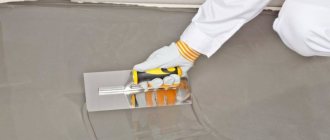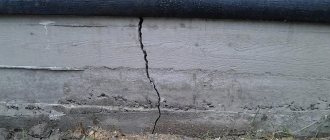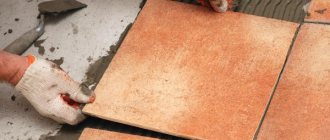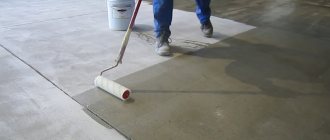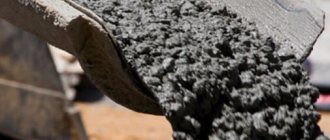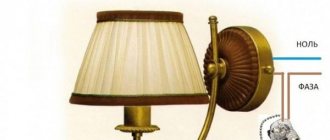How long does it take for wall primer to dry?
The material contains polymer and other additives that improve adhesion and other qualities of the product.
The drying time of the mixture depends on the type of primer.
The following types can be found on the market:
- Slow drying. Polymerization of the primer mixture requires at least 24 hours.
- With medium drying speed. It takes 4-12 hours for the mixture to completely harden. To find out the exact drying time of the material, you should read the manufacturer's instructions indicated on the packaging.
- Quick-drying (in 1-2 hours). This group includes enamel and alkyd mixtures. It should be remembered that primers of this type are extremely toxic (can cause harm to health), but after treatment you can quickly begin applying decorative materials, wallpaper and other coatings.
When working with such a primer mixture, it is important to use protective gloves, a respirator and goggles (intended for construction work). It should be remembered that a mixture that hardens too quickly is not always useful, since the adhesive properties of such a solution are weaker, which can lead to surface deformation.
On a concrete wall
For concrete surfaces, an adhesive primer is most often used; it takes 24 hours for the mixture to dry completely. The speed of the process also depends on environmental conditions (degree of humidity, temperature, etc.).
On brick with plaster
Half a working day is required for polymerization.
On a concrete wall before plaster
It is not necessary to wait until the primer material has completely polymerized before plastering. The exception is some decorative materials.
On wooden walls
To coat wooden surfaces, high-quality primers are required; most often, builders use oil-based mixtures. The coatings dry within 12-24 hours, the time depends on the composition of the manufacturer’s mixture and the conditions of use (temperature, humidity level, coating thickness, etc.).
On the market you can find quick-drying oil-based compounds intended for interior work. For example, this is a mixture of Kilz Original (the material takes only 1 hour to dry).
Drying time for deep penetration primer
Often, before applying decorative materials, a deep penetration primer is used; it helps prevent the appearance of various stains on the base after drying, as well as ensure good adhesion for future coatings. The characteristics of these primers may vary between manufacturers. To allow the coating to dry, leave the mixture on the wall for 24 hours.
Which will dry the walls or ceiling faster?
The finishing material dries faster on the ceiling (thanks to warm air).
What affects drying time?
The following factors influence polymerization:
- Coating thickness. The larger it is, the slower the evaporation process in the mixture occurs.
- Temperature. Excessively high and low rates negatively affect the drying process. The recommended temperature for applying the primer is +15… +30°C. Humidity should not exceed 80%. If the indicators are lower, then polymerization will take longer.
- Composition of the mixture. If earlier it was necessary to use the same primer composition for finishing work, today, thanks to the rapid development of industry and wide technological capabilities, it is possible to use different types of mortar (for different purposes and tasks).
- Best before date. Please pay attention to this factor before using the product. The drying time, adhesion and strength of the coating depend on the quality of the solution.
How long should you wait before wallpapering?
Requires 4-24 hours.
How long to wait before applying putty
Most often, wait 12-24 hours before applying putty.
Correct use of primer
Do not start decorating the wall until the primer material has completely dried. To find out exactly how long it will take for polymerization, study the information on the packaging.
To speed up the drying process of the primer, provide good ventilation in the room, lower the humidity level, increase the temperature, use a high-quality mixture, and distribute it over the surface using a sprayer.
The correct application technique is as follows:
- First prepare the surface. It is cleaned, degreased and dried. The adjacent areas are covered with paper. Before preparing the solution, it is important to read the instructions on the package so that it does not turn out too thick or liquid.
- The primer material is applied to the wall in a thin layer. If a secondary coating is used, the primer mixture is applied immediately before the first layer has completely dried.
- After priming, they begin to apply decorating materials.
The correct technology for applying deep primer:
- Before starting the process, prepare the base: remove the old coating (plaster, paint, etc.), because The mixture should only be applied to a clean, hard and stable surface. There should be no dust, grease or dirt on the wall, otherwise the mixture will not be able to properly attach to the base.
- Do not apply material that has expired.
- The mixture is applied to the surface at a temperature of +5…+25°C.
- To distribute the mixture on the wall, use a special brush or plush roller.
- During finishing work, use protective glasses and gloves.
Helpful Tips:
- Experts recommend using a dehumidifier when working to reduce the humidity level in the room.
- It is recommended to open windows to allow free air flow in the room.
- To create a thin layer on the surface, use a sprayer.
- It is very important to avoid any, even the slightest, drafts. Otherwise, the primer layer will not be able to dry evenly on the surface.
- It is not recommended to use dryers and other devices that produce hot air to speed up the polymerization process (by heating the wall). This procedure will not reduce the drying time, but will only worsen the adhesive properties of the material.
Types of primer compositions
The building materials market offers a solid selection of primers from different manufacturers. Primer mixtures differ in composition, purpose and drying time; they can be universal or special, for interior or exterior work.
Based on their properties and purpose, primers can be divided into the following types:
- Concrete contact - the mixture includes quartz sand, cement, and other fillers; an acrylic binder is the basis of the composition. Designed to increase the adhesion of smooth, weakly absorbent surfaces (concrete, tiles, old paint) with plasters, putties, and ceramic tile adhesives.
We recommend: Zinc-containing primer for metal
USEFUL INFORMATION: How to make a plasterboard wall with your own hands
- Penetrating universal – prepares surfaces before tiling and painting. Strengthens loose, crumbling substrates and reduces their absorption capacity.
- Colorless - used for treating wooden surfaces in order to preserve the natural structure of the wood. Forms a waterproof film that protects the wood from rotting.
- Contact – enhances the ability of a hard surface to “adhere” to various solutions (paints, adhesives).
- Film-forming – used when working with problematic surfaces. Strengthens the base, creates a film that limits the flow of moisture. Can be applied to any surface, from cement floors to fiberboard. It dries quickly, which is convenient when deciding to put wallpaper on the walls.
Compositions of primers and their setting period
The primer material plays an important role in the finishing process, so when choosing, you should carefully pay attention to its composition and properties. The choice of a particular product depends on the room, type of surface and many other factors.
The following types of solutions can be found on the market:
- Acrylic. Manufactured on the basis of acrylic resins. Suitable for almost any substrate, the primer is evenly distributed over the surface, hiding minor defects. The technology allows the mixture to be applied to the wall in a thick layer.
- Alkyd. Most often, such coatings are applied to textured solid substrates (PVC tiles, steel, wood, metal, etc.).
- Alcohol. Suitable for finishing wooden walls.
- Colorless primers (water-based). Designed for treating interior walls.
- Mineral. Produced on the basis of cement and mineral elements. Suitable for priming brick, concrete and other types of walls.
- Anti-corrosion. Manufactured on the basis of polyvinyl resins. Provide good adhesion to various types of surfaces and are highly resistant to corrosion. It is recommended to apply the mixture in a thin layer (as opposed to an acrylic primer). The material is suitable for coating steel, aluminum and galvanized substrates.
- Primers for dry walls. The compositions are most often used to coat drywall. The mixtures perfectly close pores and provide an even layer on the surface. The primer helps seal the drywall, prevents it from cracking, and prevents the penetration of solvents contained in the finish coat.
- Epoxy. Made on the basis of epoxy resin. The compositions are highly resistant to mechanical damage. An epoxy mixture is used to coat steel and concrete walls. The composition contains anti-corrosion additives and components that ensure good adhesion of the primer to the base. The mixtures are widely used both in the automotive industry and in construction.
The main advantages of epoxy primer:
- insulating and anti-corrosion properties;
- good adhesion to various types of substrates;
- Suitable for application on steel, zinc and aluminum.
When choosing a primer material, not only climatic conditions, the type of base, but also the composition are taken into account.
The wrong choice of primer can negatively affect both the quality of repairs and health (there are building materials that are not intended for use in residential premises).
You need to know how long it takes for different compositions to dry:
- Acrylic primer requires a minimum of 8 hours.
- For oil solutions, the time is more than a day (quick-drying oil primers that can dry in 6-7 hours are also available for sale).
- Alkyd solutions dry in 10-12 hours.
- The drying time of the epoxy primer is 90 minutes at a room temperature of + 20°C and 30 minutes at a temperature of 60°C.
- Water-based latex primer polymerizes quickly (in 30-60 minutes, for some formulations - in 1-2 hours). The rate of polymerization also depends on the thickness of the applied layer.
- Primers for dry walls dry within 30 minutes, for some manufacturers - within 2 hours, there are also compositions that require more than a day. Environmental conditions such as temperature and other factors play an important role in the polymerization rate of the primer material.
Description and technical specifications
Another name for a bitumen primer is a primer based on bitumen with the addition of compounds such as white spirit or kerosene, with a uniform texture. Depending on the technical characteristics and scope of application, the composition may include other elements. Initially, the primer was used to simplify and reduce the cost of waterproofing surfaces. Its distinctive technical characteristics are as follows:
- minimal drying time;
- excellent resistance to high temperatures and freezing;
- 100% air and moisture proof.
When developing this material, specialists assumed its primary use in insulation work:
- concrete structures;
- base slabs;
- foundation;
- screeds.
Practical characteristics add to the popularity of the primer:
- bitumen material can withstand a wide range of working surface temperatures - from minus 50 to plus 120 degrees. It turns out that this insulator can be used in different weather conditions, since it will not lose its strength characteristics;
- elasticity of the ready-to-use composition;
- the speed of readiness of the treated surface for further finishing. Depending on the degree of concentration, the plane is ready for use in 1-5 hours;
- another plus is anti-corrosion;
- ease of application - on a dry surface with any appropriate tool;
- good adhesion and spreadability - just one layer is enough.
The solution is economical and is sold in concentrated form; it can be diluted to the desired consistency. There are two types of primer on sale:
- Ready - can be used immediately after thorough mixing.
- Concentrated - must be diluted to the desired state before use.
In addition, the primer is classified according to the scope of application:
Roofing - designed to cover defects of all porous surfaces on the roof before waterproofing is applied to it. It is also used instead of an adhesive composition when installing soft tiles or sheet roofing.- Road - used as a binding component when laying roads (filling crushed stone).
- Pipeline is an anti-corrosion material with high adhesion rates.
- Universal - used in all situations, except those used in special conditions with special components.
In some construction retail outlets you can find bitumen primer without labels and identification marks - it is better to refuse such a purchase, especially if the seller cannot provide documents and certificates.
What affects the setting speed of impregnation?
Main factors:
- Low temperatures slow down the drying of the primer. If the room is cold, it is recommended to increase the temperature.
- Oil-based primers take much longer to dry than water-based ones. Some manufacturers' compounds dry more slowly, because... the mixture contains more oil. To speed up the polymerization process, choose a brand with less oil and more pigments.
Primed walls, when should they dry?
The minimum time is 1-4 hours (for quick-drying compounds), the maximum is 48 hours.
Drying time for popular compositions:
- Kills primer is oil or latex based. The primer dries before applying putty for 1 hour (at optimal temperature and humidity). The mixture perfectly insulates the coating and prevents the growth of mold and mildew.
- The Rustoleum Primer mixture dries for 1 hour at temperatures of +21...+27°C and humidity 50%. After applying the primer, you can begin decorating the wall.
Peculiarities
It is important to know how long it will take for the primer to dry. This is necessary information for workers and craftsmen to know when to start a new stage of repair work. This indicator is extremely important in the process of major repairs and finishing works.
This is a unique product that helps improve adhesion. The main advantage of the primer is its binding ability. Thanks to this characteristic, the consumption of paint, adhesive and other materials is significantly reduced . High-quality primer material has good antibacterial and antifungal properties. Thanks to these characteristics, you can safely hang wallpaper and not be afraid of the appearance of fungus and mold in the future.
A number of people consider the use of this product before painting or pasting walls to be pointless. Most often this concerns novice craftsmen or people who want to independently carry out repairs in their home. Only over time do they begin to understand how deeply they were mistaken. After all, preliminary priming of walls helps to save a lot by reducing the consumption of finishing materials.
We recommend: Primer for facade: purposes of application, properties and application procedure
After applying the primer to the wall, you must wait some time before continuing with the repair work. Manufacturers usually indicate the waiting time on the solution packages . But this criterion may change due to the type of foundation and other aspects. If there is a dry or porous surface, it is possible to begin further work in a very short time.
Before purchasing this product, you should decide on what surfaces it will be used. Do not forget about the instructions included with the solution. The higher the penetrating ability of the primer, the better quality it is.
